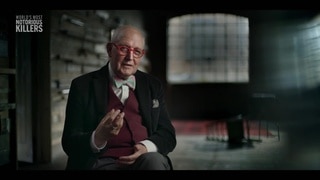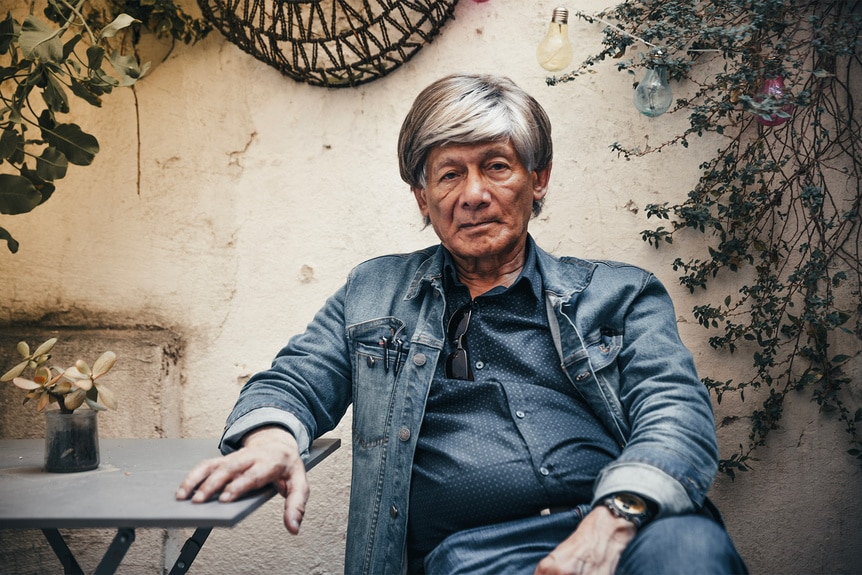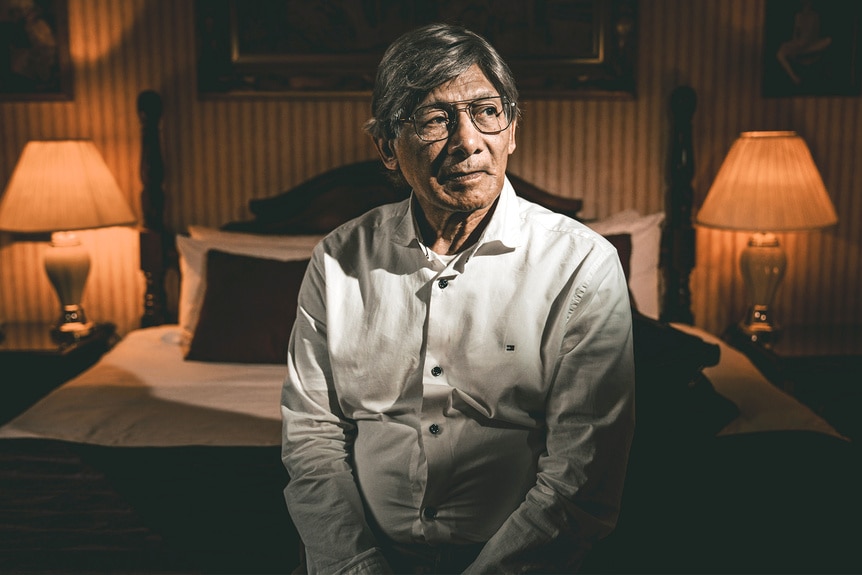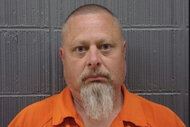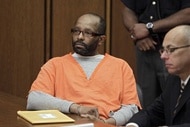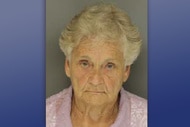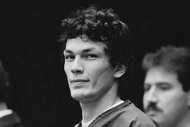Create a free profile to get unlimited access to exclusive videos, breaking news, sweepstakes, and more!
Why Was Serial Killer Charles Sobhraj Nicknamed the Bikini Killer and The Serpent?
Serial Killer Charles Sobhraj, who found his victims along the Hippie Trail in the 1970s, preyed on unsuspecting Western backpackers.
The Hippie Trail of the '60s and ‘70s stretched from Europe through South Asia, attracting young Western backpackers and free-spirited wanderers searching for adventure.
"It was the perfect dream of peace and harmony and getting stoned,” Georgina Nunez, a robbery victim of serial killer and fraudster Charles Sobhraj, whom he sought to coercively control, said on Peacock's new true crime docuseries, World’s Most Notorious Killers.
At first glance, Sobhraj — who found his victims at stops along this trail — fit right in. He was charismatic and handsome, wore silk shirts, and traded in rare gems. But looks were deceiving.
Sobhraj, who operated under the alias “Alain Gautier,” preyed on unsuspecting backpackers by befriending them, sometimes poisoning people and nursing them back to health to gain their trust. His “snake-like” ability to charm people to their deaths — all while evading capture — earned him the nickname "The Serpent." And just like a snake, Sobhraj would shed his skin, so to speak, using his victims’ identities and passports to travel to different countries and commit more crimes.
Primarily based out of Thailand, Sobhraj committed many of his evil acts in Bangkok and, for a time, at the beach resort of Pattaya on the Gulf of Thailand's east coast. He was also dubbed the "Bikini Killer" after at least two of his victims were found drowned, wearing only a two-piece bathing suit.
Who was Charles Sobhraj?
Sobhraj was born in Saigon, Vietnam on April 6, 1944, to a Vietnamese mother and an Indian father, though the two never wed. His mother went on to marry a French soldier, and they relocated to France, where a young Sobhraj acted out and often ran away from home, attempting to return to his dad. “There’s this ruthlessness that starts very, very young, where he’s moved around constantly,” historian Nell Darby said on "The Serpent" episode of World’s Most Notorious Killers, now streaming.
His life of crime began at age 18 when he stole a car. “I didn’t know how to drive,” he told producers of the Peacock show in a U.S. exclusive interview, adding, “The cops came, and then they sent me to jail for six months.”
In the ‘60s, he bounced around from Greece to the Middle East to Central Asia, drugging and robbing tourists at hotels and doing early prison stints in Tehran, Iran and Athens.
In 1975, he arrived in Thailand with his Canadian girlfriend and future accomplice, Marie-Andrée Leclerc, who went by the alias “Monique.” That same year, he killed his first known victim.
RELATED: How a "Family Joke" About a Teen "Under the Patio" Led to Serial Killer Couple's Capture
How many people did Charles Sobhraj kill?
Sobhraj was convicted of two murders but confessed to killing at least nine people, and is suspected of killing double that amount during his peak crime years, from 1970 to 1976. Though he freely admits to fleecing tourists, jewelry heists, and various druggings, Sobhraj now says he never killed anyone, and has retracted previous confessions. In total, Sobhraj has spent about 40 years in jail, including 19 years in Nepal for murder.
Charles Sobhraj’s suspected victims
Teresa Knowlton, a 21-year-old from Seattle, was his first known victim. She met Sobhraj on her way to join a Buddhist monastery and was found drowned in a tidal pool in Pattaya wearing a floral bikini.
His second alleged victim was Vitali Hakim from Turkey, whose scorched remains were discovered on the road leading to the Pattaya resort where Sobhraj was selling gems. “Then there was Stéphane Parry. Some accounts say she was Vitali Hakim’s girlfriend,” said historian Darby. After she came looking for Hakim and met with Sobhraj, she turned up dead, in a bikini.
In December of 1975, the burnt bodies of two Dutch backpackers, both in their 20s, were discovered on a Thai beach. Cornelia Hemker and Henricus Bintanja, an engineering student, met the French “gem dealer” in Hong Kong, and he invited them to Thailand for a visit. The couple were drugged, strangled, doused in gasoline, and set on fire. This time, police questioned Sobhraj and his alleged accomplice Ajay Chowdhury (who later mysteriously disappeared). But before he was arrested, Sobhraj fled to Kathmandu in Nepal with his girlfriend Leclerc, using the passports of the deceased backpackers.
Within a week of their arrival in Kathmandu, two bodies bearing burns and knife wounds were discovered on the city’s outskirts: Connie Jo Bronzich, a 29-year-old American radiology student, and Laurent Carrière, a 26-year-old Canadian backpacker. After being questioned by the police, Sobhraj and Leclerc went back to Thailand, using their alleged victims’ passports.
By this time, Leclerc had been “drawn deeper and deeper into his criminal schemes,” said journalist Tim Tate, who described Leclerc as Sobhraj’s “prisoner” on World's Most Notorious Killers. The two were accused of killing Israeli scholar Alan Aron Jacobs in a hotel room while he was on vacation to India in 1975. Then came Frenchman Jean-Luc Solomon, who was drugged and murdered during a robbery. Sobhraj used Jacobs’ passport to travel between Singapore, India, and Thailand to evade police.
Though Sobhraj was found guilty of killing Jacobs and Solomon, he was later acquitted due to a lack of evidence. Leclerc was acquitted of Solomon’s death and convicted for Jacobs' but released on appeal. She died of cancer in 1984.
RELATED: The Wives and Girlfriends Who Aided or Stood By the World's Most Notorious Killers
In the spring of 1976, Interpol and Thai police issued an arrest warrant for Sobhraj and his accomplices, thanks to Nadine Gires, his neighbor who came forward, and the efforts of Dutch diplomat Herman Knippenberg and his then-wife, Angela Kane, who were based in Bangkok.
The parents of Hemker and Bintanja had reached out to Knippenberg with concerns when communication with the Dutch couple suddenly stopped. Around that time, Gires had alerted a few embassies that “something strange was going on” at Sobhraj’s apartment. “These people would come, and they would visit, and they would be ill, and then suddenly, people just disappeared,” Kane said on World's Most Notorious Killers.
After Gires found the Dutch couple’s travel journal at Sobhraj’s apartment and identified them from photos, “we knew we had to investigate,” Kane said. Two bodies had turned up on a Bangkok beach and were burnt beyond recognition. At first, authorities believed they were Australian until dental records identified them as the missing Dutch backpackers.
There was no conviction in regard to the Dutch backpackers' deaths though. “Sobhraj was able to bribe his way out of custody with stolen stones,” Tate said.
By the time Interpol had issued an international arrest warrant, Sobhraj was locked up in Tihar Prison in India. He had been sentenced to 12 years for drugging 60 French students in a hotel. “The problem is when almost I had reached the end of the 60th student, the first one started to fall down. The scene was like a horror movie. But the hotel staff become panicky,” Sobhraj said on World's Most Notorious Killers.
RELATED: The Heinous Crimes Committed By the World's Most Notorious Killers
While doing time for the mass drugging, several other charges were brought against Sobhraj, including the ones that led to murder convictions for Jacobs' and Solomon's deaths, which were overturned.
When the end of his jail time was approaching, a New Delhi court made moves to extradite him to Thailand so he could finally stand trial for murder. But Sobhraj eluded justice again. He and a small group of inmates pulled off a brazen jailbreak by slipping valium into the guards’ tea. After living it up for weeks at casinos in the seaside town of Goa, India, he was rearrested and thrown back in Tihar Jail, where he remained for another 10 years, avoiding extradition while his Thailand murder cases lapsed.
In 1997, at the age of 53, he was released and returned to France as a free man.
Charles Sobhraj brought to justice in Nepal
Unlike in Thailand, there is no statute of limitations for murder in Nepal, and justice finally came for the killings of American student Bronzich and Canadian backpacker Carrière some 28 years later, in 2003.
Six years after his release from prison in India, Sobhraj made the mistake of traveling to Nepal, a decision he described as a “fatal error” in his memoir, Moi, le Serpent. A reporter from The Himalayan Times happened to spot Sobhraj at a local casino playing baccarat and wrote a front-page article that led to his arrest. He was tried for murder and convicted of Bronzich’s death in 2004 and Carrière’s in 2014.
RELATED: Wrong Twin Suspected After Teacher Fatally Shot in Her Car and Clues First Point To Him
Where is Charles Sobhraj now?
After serving 19 years for Bronzich and Carrière's deaths, Sobhraj was released from prison in Nepal in 2022 and returned to France to start a new life. Now 80, he published a memoir in February 2023 and is traveling the world to tell his story.
He continues to spout his fanciful tales of smuggling and gem trading, claiming that international intelligence agencies and security operatives seek him out for his expertise. Convicted of two murders and suspected of many more, only The Serpent knows the true tally.
